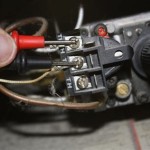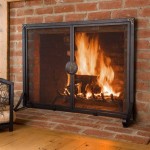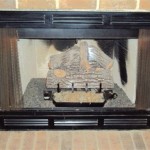```html
Maintenance On A Gas Fireplace Ventless
Ventless gas fireplaces offer a convenient and aesthetically pleasing alternative to traditional wood-burning fireplaces. They are relatively easy to install and operate, providing supplemental heat without the need for a chimney or vent. However, like any appliance that burns fuel, regular maintenance is crucial for ensuring safe and efficient operation. Neglecting maintenance can lead to a variety of problems, including reduced heating efficiency, carbon monoxide buildup, and potential fire hazards. This article provides a detailed overview of the maintenance procedures necessary to keep a ventless gas fireplace functioning optimally.
Understanding Ventless Gas Fireplace Operation
Before delving into specific maintenance tasks, it's important to understand how a ventless gas fireplace operates. Unlike vented models that exhaust combustion byproducts through a chimney, ventless fireplaces are designed to burn gas more completely. They rely on an Oxygen Depletion Sensor (ODS) to monitor oxygen levels in the room. If oxygen levels drop below a certain threshold, the ODS shuts off the gas supply to prevent carbon monoxide poisoning. This feature is critical to the safe operation of a ventless fireplace. However, the completeness of combustion and the effectiveness of the ODS are dependent on proper maintenance and adherence to safety guidelines.
These fireplaces typically use either liquid propane (LP) or natural gas (NG) as fuel. Each fuel requires specific settings and components, so it's crucial to ensure the fireplace is properly configured for the intended fuel source. Converting a fireplace from one fuel to another should only be performed by a qualified technician.
Ventless fireplaces also generate moisture as a byproduct of combustion. While this is generally not a significant concern in well-ventilated spaces, it can contribute to condensation and mold growth in poorly ventilated areas. Therefore, ensuring adequate ventilation in the room where the fireplace is located is paramount.
Essential Maintenance Tasks
Regular maintenance of a ventless gas fireplace involves several key tasks, including cleaning, inspecting, and testing components. The frequency of these tasks depends on usage patterns, but a general guideline is to perform a thorough inspection and cleaning at least once a year, ideally before the start of the heating season. More frequent cleaning may be necessary if the fireplace is used frequently.
Cleaning the Burner Assembly: The burner assembly is the heart of the fireplace, where the gas is ignited and combustion occurs. Over time, dust, debris, and soot can accumulate on the burner, obstructing gas flow and reducing combustion efficiency. To clean the burner, first, turn off the gas supply to the fireplace. This is usually accomplished by closing the gas shutoff valve located near the fireplace. Allow the fireplace to cool completely before proceeding.
Next, carefully remove any decorative logs or rocks from the fireplace. These components may be fragile, so handle them with care. Consult the fireplace's owner manual for specific instructions on removing the logs or rocks. Once the logs are removed, locate the burner assembly. Depending on the model, the burner may be held in place by screws or clips. Remove any fasteners and carefully lift the burner assembly out of the fireplace.
Use a soft brush or vacuum cleaner with a brush attachment to remove loose dust and debris from the burner. For stubborn deposits, a mild detergent solution can be used. Apply the solution sparingly and avoid getting any liquid into the gas orifices. Use a small wire or needle to carefully clean out any clogged gas orifices. Be extremely careful not to enlarge or damage the orifices, as this can affect gas flow and combustion characteristics.
Once the burner is clean, rinse it thoroughly with water and allow it to dry completely before reassembling the fireplace. Ensure that all components are properly aligned and secured before turning the gas supply back on.
Cleaning the Pilot Light Assembly: The pilot light is a small flame that ignites the main burner. A clean and properly functioning pilot light is essential for reliable ignition. Dust and debris can accumulate around the pilot light assembly, interfering with ignition and causing the pilot light to extinguish frequently. To clean the pilot light assembly, follow the same safety precautions as when cleaning the burner assembly: turn off the gas supply and allow the fireplace to cool completely.
Locate the pilot light assembly, which is typically located near the main burner. Use a soft brush or vacuum cleaner to remove loose dust and debris from the assembly. Pay particular attention to the pilot light orifice, which is a small opening that supplies gas to the pilot light. A clogged pilot light orifice can cause the pilot light to be weak or unsteady. Use a small wire or needle to carefully clean out the pilot light orifice. Again, exercise extreme caution to avoid enlarging or damaging the orifice.
Once the pilot light assembly is clean, reassemble the fireplace and turn the gas supply back on. Check the pilot light to ensure it is burning with a strong, steady flame. If the pilot light remains weak or unsteady after cleaning, the pilot light assembly may need to be replaced.
Inspecting and Cleaning the Oxygen Depletion Sensor (ODS): The ODS is a critical safety component that monitors oxygen levels in the room. If the ODS detects a decrease in oxygen levels, it shuts off the gas supply to prevent carbon monoxide poisoning. A dirty or malfunctioning ODS can lead to nuisance shutdowns or, more seriously, failure to detect low oxygen levels.
The ODS is typically located near the pilot light assembly. Inspect the ODS for any signs of damage or corrosion. Use a soft brush to remove any dust or debris from the ODS. Avoid using any cleaning solutions, as these could damage the sensor. Test the ODS by simulating a low-oxygen environment. Consult the fireplace's owner manual for specific instructions on testing the ODS. If the ODS fails the test, it should be replaced immediately by a qualified technician.
Safety Considerations
In addition to routine maintenance, several safety considerations are important when operating a ventless gas fireplace.
Carbon Monoxide Detectors: Install and maintain carbon monoxide detectors in the vicinity of the fireplace. Carbon monoxide is a colorless, odorless gas that can be deadly. A carbon monoxide detector will provide an early warning of a carbon monoxide leak. Test the detectors regularly to ensure they are functioning properly. Replace batteries annually, or as recommended by the manufacturer.
Ventilation: Ensure adequate ventilation in the room where the fireplace is located. While ventless fireplaces are designed to burn gas more completely than vented models, they still produce some combustion byproducts, including carbon dioxide and water vapor. Opening a window or door slightly can help to circulate air and prevent the buildup of these byproducts. Refer to the fireplace's owner's manual for specific ventilation requirements.
Clearance: Maintain adequate clearance around the fireplace. Keep flammable materials, such as furniture, curtains, and paper, away from the fireplace. Consult the fireplace's owner's manual for specific clearance requirements. Never place anything on top of the fireplace or block the air inlets.
Professional Inspection: Schedule a professional inspection of the fireplace at least once every two years. A qualified technician can inspect the fireplace for potential problems, such as gas leaks, faulty components, and improper venting. The technician can also perform a carbon monoxide test to ensure that the fireplace is operating safely.
Don'ts: Do not operate the fireplace if it is damaged or malfunctioning. Do not attempt to repair the fireplace yourself unless you are a qualified technician. Do not use the fireplace to burn anything other than natural gas or propane. Do not block the air inlets or outlets of the fireplace.
Troubleshooting Common Problems
Despite regular maintenance, problems can still arise with a ventless gas fireplace. Understanding common problems and their potential causes can help to diagnose and resolve issues more effectively.
Pilot Light Won't Stay Lit: A pilot light that won't stay lit can be caused by a variety of factors, including a dirty pilot light orifice, a faulty thermocouple, or a low gas supply pressure. Clean the pilot light orifice as described above. If the problem persists, the thermocouple may need to be replaced. The thermocouple is a small sensor that generates a small electrical current to keep the gas valve open. A faulty thermocouple will not produce enough current, causing the gas valve to close and extinguish the pilot light. A low gas supply pressure can also cause the pilot light to extinguish. Check the gas supply to ensure that it is adequate. If the gas supply is low, contact the gas company to investigate the problem.
Burner Flame Is Yellow or Sooty: A yellow or sooty burner flame indicates incomplete combustion. This can be caused by a dirty burner, a clogged gas orifice, or insufficient air supply. Clean the burner and gas orifices as described above. Ensure that the air inlets of the fireplace are not blocked. If the problem persists, the gas pressure may need to be adjusted by a qualified technician.
Odor: A gas odor indicates a gas leak. Immediately turn off the gas supply to the fireplace and evacuate the area. Contact the gas company or a qualified technician to investigate the source of the leak. Do not attempt to repair the leak yourself. A burning odor, if accompanied by visual indications from the fireplace, should be treated with the same caution as a gas leak.
Nuisance Shutdowns: Frequent shutdowns of the fireplace can be caused by a faulty ODS, a drafty location, or insufficient ventilation. Inspect and clean the ODS as described above. Ensure that the fireplace is not located in a drafty area. Improve ventilation in the room by opening a window or door slightly. If the problem persists, the ODS may need to be replaced.
By adhering to these maintenance procedures and safety guidelines, owners can ensure the safe and efficient operation of their ventless gas fireplaces for years to come. However, it is crucial to remember that regular maintenance is not a substitute for professional inspection and repair. If any problems are encountered that cannot be resolved through routine maintenance, a qualified technician should be consulted.
```
Ventless Gas Fireplace Maintenance Guide Fireplaces Direct Learning Center

Vent Free Gas Burner Maintenance

Ventless Gas Fireplace Maintenance Guide Fireplaces Direct Learning Center

Why Is It Important To Get My Gas Fireplace Logs Clean Regularly

Ventless Gas Fireplace Propane

Fireplaces Gas Fireplace Guidelines Maintenance

Gas Fireplaces Need Regular Servicing For Optimum Condition And Safety

Vent Free Gas Logs Pros And Cons Kansas City Chimney Service

Reasons Your Gas Fireplace Isn T Working Experts

Caring For A Ventless Gas Fireplace
Related Posts








